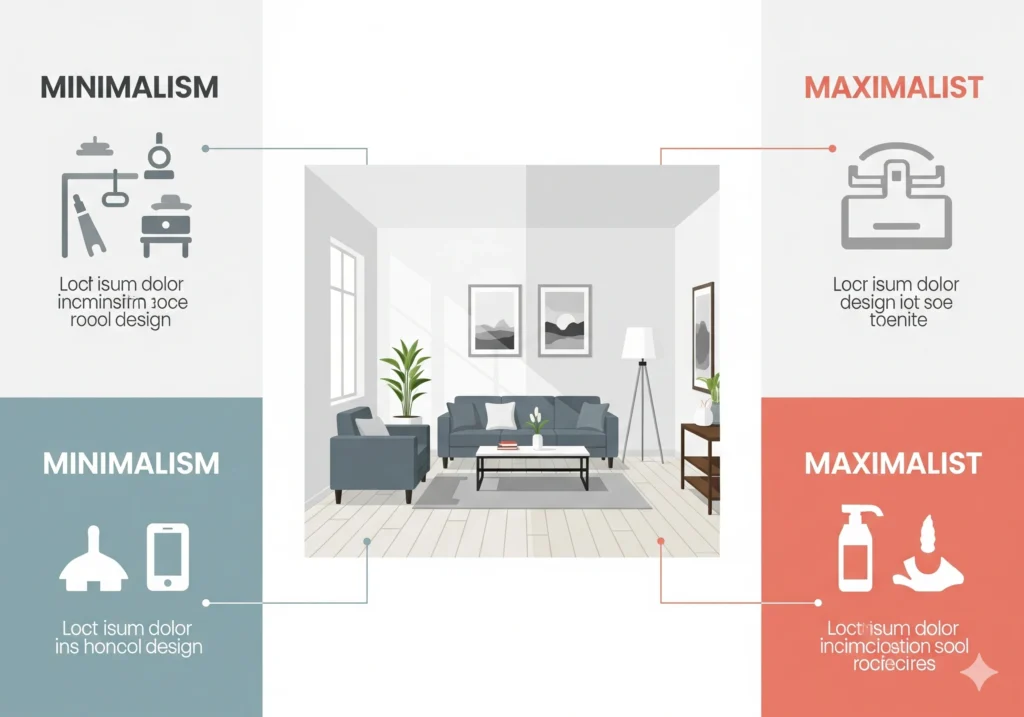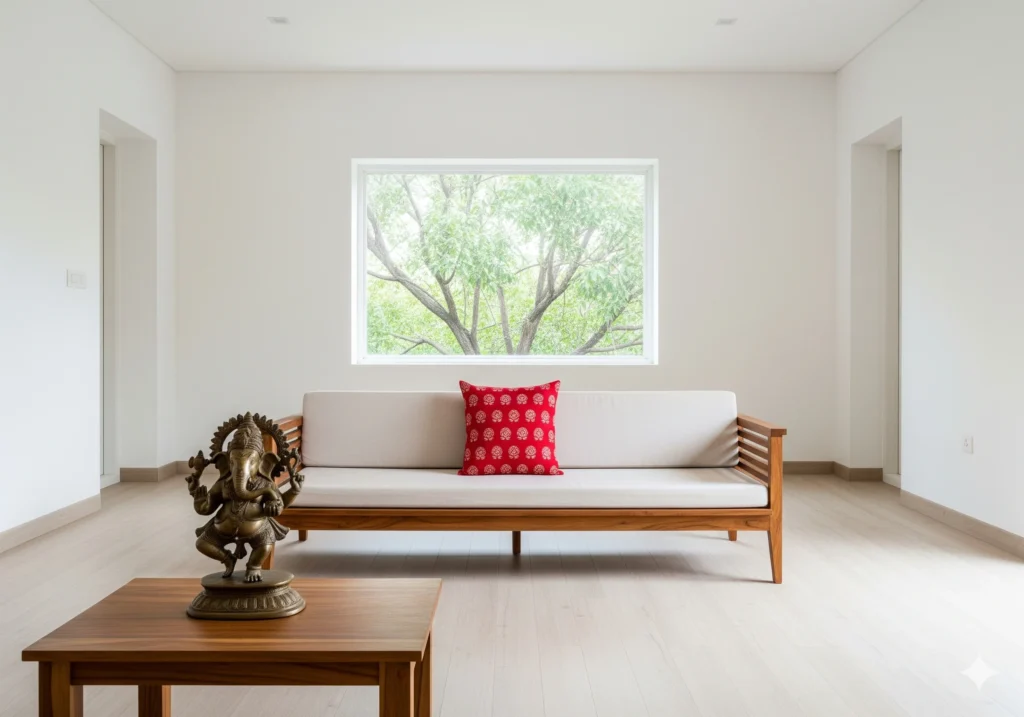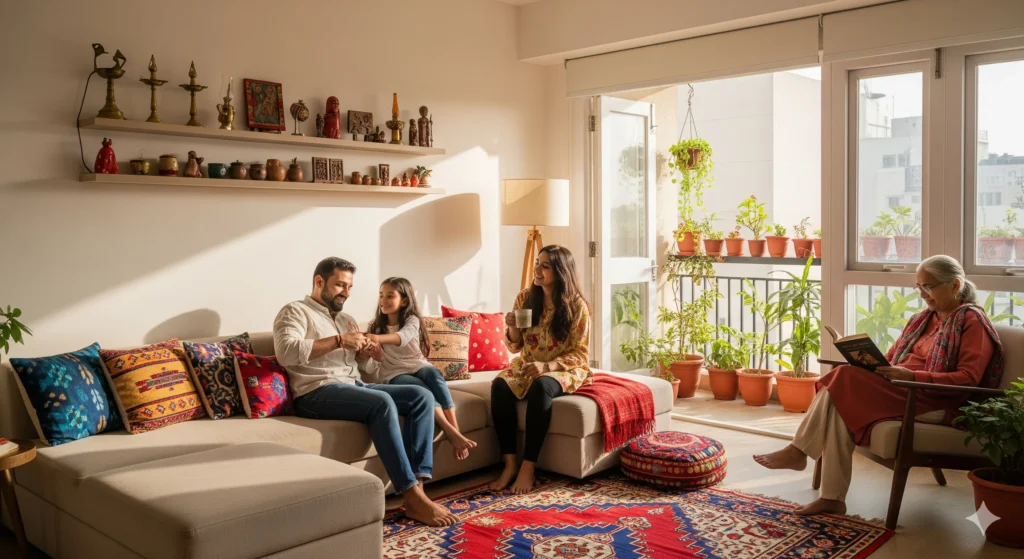In the dynamic realm of interior design, two contrasting philosophies—minimalism vs. maximalism in home design—shape how we craft our living spaces. Minimalism, with its clean lines, neutral palettes, and uncluttered ethos, champions simplicity and functionality, fostering calm and clarity. Maximalism, on the other hand, revels in bold colors, eclectic patterns, and layered textures, celebrating individuality and creative expression. As we navigate 2025, the debate of minimalism vs. maximalism in home design is evolving, with homeowners increasingly seeking a harmonious blend that balances minimalism’s serenity with maximalism’s vibrancy. This fusion creates spaces that are both practical and deeply personal, reflecting modern lifestyles.
In India, where cultural richness meets contemporary design trends, the tension between minimalism vs. maximalism in home design is particularly relevant. Firms like Archtra are helping clients navigate this spectrum, crafting homes that resonate with both global aesthetics and local traditions. This comprehensive guide explores minimalism vs. maximalism in home design, comparing their principles, impacts on spatial planning, lifestyle influences, 2025 trends, and strategies for achieving balance. By understanding these styles, homeowners can design spaces that align with their values, whether they lean toward sparse elegance or exuberant abundance.
The interplay of minimalism vs. maximalism in home design is not about choosing one over the other but finding a synergy that enhances well-being and aesthetics. From minimalist open-plan layouts to maximalist gallery walls, this article offers insights and practical tips to create a home that’s uniquely yours. Whether you’re redesigning a compact Mumbai apartment or a sprawling Bangalore villa, the principles of minimalism vs. maximalism in home design provide a roadmap for intentional, inspiring spaces.
Defining Minimalism and Maximalism in Home Design
Minimalism: The Art of Less
Minimalism in home design is rooted in the philosophy of “less is more,” drawing inspiration from Japanese Zen aesthetics and Scandinavian simplicity. It emphasizes open spaces, neutral color schemes (whites, beiges, grays), and essential furnishings that serve multiple purposes. In minimalism vs. maximalism in home design, minimalism prioritizes functionality, reducing visual clutter to create serene, calming environments. Furniture is sleek, often with clean lines and hidden storage, maximizing space efficiency. Materials like wood, glass, and metal dominate, creating a timeless, understated elegance. Minimalist homes feel airy and tranquil, offering a respite from the chaos of urban life.

Maximalism: The Celebration of More
Maximalism, in contrast, embraces “more is more,” celebrating bold, eclectic, and expressive design. In minimalism vs. maximalism in home design, maximalism is defined by vibrant colors, intricate patterns, and a curated mix of textures and objects. Think jewel-toned walls, layered rugs, and shelves brimming with art, books, and cultural artifacts. Maximalist spaces tell personal stories, reflecting the occupant’s personality through vintage finds, bold wallpapers, and global-inspired decor. This style thrives on abundance, creating dynamic, energetic environments that spark creativity and conversation.
The Middle Ground
The debate of minimalism vs. maximalism in home design isn’t binary. A balanced approach, often called “mindful maximalism” or “warm minimalism,” combines minimalism’s clarity with maximalism’s personality. For example, a minimalist base with neutral walls can be accented with maximalist elements like a colorful tapestry or statement chandelier, creating a space that feels both cohesive and vibrant. This hybrid approach is gaining traction in minimalism vs. maximalism in home design as it caters to diverse tastes while maintaining functionality.
Spatial Planning: How Each Style Shapes Space
Minimalism’s Approach to Spatial Planning
In minimalism vs. maximalism in home design, minimalism excels in creating open, flexible layouts that maximize space. Minimalist homes often feature open-plan designs where living, dining, and kitchen areas flow seamlessly, enhanced by large windows for natural light. Furniture is multi-functional—a sofa bed or a foldable dining table—reducing clutter while maintaining utility. In minimalist spatial planning, every element has a purpose; storage is cleverly integrated to keep surfaces clean, fostering a sense of calm. For small urban homes, this approach in minimalism vs. maximalism in home design is ideal, as it makes compact spaces feel larger and more inviting.
Maximalism’s Dynamic Layouts
Maximalist spatial planning, in contrast, embraces division and depth. In minimalism vs. maximalism in home design, maximalist homes use bold zoning techniques—think vibrant area rugs, patterned screens, or statement walls—to define distinct areas within a space. Rooms are layered with furniture, art, and decor, creating cozy nooks and dynamic focal points. For example, a maximalist living room might feature a plush velvet sofa, a gallery wall of eclectic art, and a mix of patterned cushions, all working together to create a rich, immersive environment. This approach thrives in larger spaces but can be adapted for smaller homes with careful curation.
Balancing Spatial Planning
Balancing minimalism vs. maximalism in home design in spatial planning involves strategic integration. A minimalist open-plan base can be enhanced with maximalist accents, such as a bold rug to define a seating area or a single statement piece like a vintage armchair. This hybrid ensures functionality while adding personality, making minimalism vs. maximalism in home design adaptable to various home sizes and layouts. In India, where space constraints are common, this balance allows for airy layouts with cultural touches like handwoven textiles.
Lifestyle Impacts of Minimalism vs. Maximalism
Minimalism’s Influence on Lifestyle
Minimalism in home design promotes a lifestyle of intentionality and mindfulness. By reducing physical clutter, it fosters mental clarity, with studies showing that minimalist environments can lower stress levels by 15-20%. In minimalism vs. maximalism in home design, minimalism suits those who value simplicity, discipline, and order. It encourages sustainable consumption by prioritizing quality over quantity, reducing the urge to overbuy. For remote workers or families seeking calm, minimalist homes create distraction-free zones that enhance focus and relaxation.
Maximalism’s Vibrant Lifestyle
Maximalism, conversely, fosters a lifestyle of creativity and self-expression. In minimalism vs. maximalism in home design, maximalist spaces energize occupants, inspiring artistic pursuits and social engagement. The abundance of decor reflects personal stories, making homes feel like curated galleries. This style suits extroverted personalities or those who thrive in vibrant, stimulating environments. However, maximalism can risk feeling chaotic if not curated thoughtfully, requiring discipline to avoid clutter.
A Balanced Lifestyle Approach
A balanced approach in minimalism vs. maximalism in home design creates a lifestyle that supports both calm and creativity. For instance, a minimalist bedroom with neutral tones can promote restful sleep, while a maximalist living area with bold art encourages social interaction. This hybrid caters to diverse needs within a household, blending minimalism’s soothing structure with maximalism’s joyful expression. In 2025, this balance resonates with families seeking versatile spaces that adapt to work-from-home, socializing, and relaxation.
Historical and Cultural Context
The roots of minimalism vs. maximalism in home design trace back centuries. Minimalism draws from Japanese wabi-sabi, valuing imperfection and simplicity, and Bauhaus principles prioritizing form and function. Maximalism echoes Victorian opulence and Indian traditions, where vibrant textiles and intricate decor reflect cultural heritage. In minimalism vs. maximalism in home design, these histories inform modern interpretations.
In India, traditional homes often leaned maximalist, with colorful rangolis and ornate furnishings. The rise of urban living has spurred minimalist trends, especially in compact apartments. Today, minimalism vs. maximalism in home design sees a fusion, with homes blending minimalist layouts with maximalist elements like handcrafted Diwali lanterns or Rajasthani prints.
Globally, the post-pandemic shift toward wellness has amplified interest in minimalism vs. maximalism in home design, with minimalism offering mental respite and maximalism celebrating personal identity in uncertain times.

2025 Trends in Minimalism vs. Maximalism
As we look to 2025, minimalism vs. maximalism in home design evolves with innovative trends. Warm minimalism gains traction, incorporating soft textures like linen and warm neutrals (terracotta, taupe) to soften stark aesthetics. Curated maximalism emphasizes intentional layering, using sustainable materials like upcycled wood or vintage textiles to avoid excess.
Technology enhances both styles in minimalism vs. maximalism in home design. Smart furniture in minimalist homes maximizes space, while maximalist spaces use AI-driven lighting to highlight bold decor. Sustainability drives trends, with minimalist eco-materials (bamboo, cork) and maximalist repurposed antiques reducing environmental impact.
In India, minimalism vs. maximalism in home design adapts to urban needs, with minimalist micro-apartments featuring maximalist accents like handwoven rugs. Globally, hybrid designs dominate, reflecting a desire for spaces that are both functional and expressive.
Real-World Examples of Minimalism and Maximalism
Minimalist Examples
The Muji House in Japan epitomizes minimalism, with its open layout, neutral palette, and multi-functional furniture creating a serene, clutter-free space. In India, a minimalist Delhi apartment by Archtra features white walls, teak furniture, and large windows, showcasing minimalism vs. maximalism in home design with a focus on airy functionality.
Maximalist Examples
A London townhouse by designer Kelly Wearstler showcases maximalism with jewel-toned walls, layered rugs, and eclectic art, creating a vibrant, personalized space. In India, a maximalist Mumbai penthouse blends Bollywood-inspired colors with antique brass decor, highlighting cultural richness in minimalism vs. maximalism in home design.
Balanced Examples
A Bangalore villa by Archtra merges minimalism vs. maximalism in home design, featuring a minimalist open-plan living area with a maximalist dining nook adorned with vibrant Indian textiles. Globally, a New York loft combines minimalist white walls with a maximalist gallery of colorful art, proving the versatility of this balance.
How to Achieve Balance in Your Home
Achieving balance in minimalism vs. maximalism in home design starts with a clear vision. Begin with a minimalist foundation: neutral walls, streamlined furniture, and open layouts. Introduce maximalist elements selectively—think a bold accent wall, a statement rug, or curated art pieces. Use color strategically; a neutral base with pops of vibrant hues ensures cohesion.
For small spaces, prioritize minimalist spatial planning with maximalist decor in moderation, like a single ornate mirror. In larger homes, zone areas with maximalist textures while keeping open spaces minimalist. In minimalism vs. maximalism in home design, balance is about intentionality—each piece should serve a purpose or tell a story.
Practical tips include:
- Declutter First: Clear unnecessary items to create a minimalist base.
- Curate Thoughtfully: Choose maximalist pieces with personal significance.
- Mix Textures: Combine minimalist smooth surfaces with maximalist tactile elements like velvet or jute.
- Consult Experts: Firms like Archtra can tailor minimalism vs. maximalism in home design to your needs.
Challenges and Solutions
Challenges
- Over-Cluttering in Maximalism: Too many decor items can feel chaotic.
- Sterility in Minimalism: Sparse spaces may feel cold or impersonal.
- Space Constraints: Urban homes struggle to balance both styles.
- Budget Limits: High-quality decor for either style can be costly.
Solutions
- Curated Maximalism: Limit decor to meaningful pieces to avoid clutter.
- Warm Minimalism: Add soft textures like throws to warm minimalist spaces.
- Multi-Functional Design: Use foldable or modular furniture to save space in minimalism vs. maximalism in home design.
- DIY and Upcycling: Repurpose items for budget-friendly maximalist flair or minimalist simplicity.
Conclusion
The debate of minimalism vs. maximalism in home design offers a spectrum of possibilities for crafting spaces that reflect personal style while enhancing functionality. Minimalism brings calm and clarity, maximalism sparks creativity and individuality, and a balanced approach merges the best of both. As 2025 trends highlight sustainability and hybrid designs, minimalism vs. maximalism in home design empowers homeowners to create spaces that nurture well-being and self-expression. Whether you’re drawn to sparse elegance or vibrant abundance, experimenting with this balance can transform your home into a sanctuary that’s uniquely yours.

Frequently Asked Questions
- What is minimalism vs. maximalism in home design? Minimalism in home design focuses on simplicity, clean lines, and neutral colors to create uncluttered, functional spaces. Maximalism embraces bold colors, layered textures, and eclectic decor to express individuality. In minimalism vs. maximalism in home design, both styles shape aesthetics and functionality, with minimalism promoting calm and maximalism fostering creativity.
- How do minimalism and maximalism affect lifestyle in home design? Minimalism encourages a mindful, stress-free lifestyle by reducing clutter, ideal for those seeking order and focus. Maximalism inspires creativity and social engagement through vibrant, personalized spaces. In minimalism vs. maximalism in home design, a balance supports both relaxation and expression, catering to diverse household needs.
- What are the spatial planning differences in minimalism vs. maximalism in home design? Minimalist spatial planning emphasizes open layouts and multi-functional furniture for airy, flexible spaces. Maximalist planning uses bold zoning with rugs and decor to create cozy, defined areas. Balancing minimalism vs. maximalism in home design involves minimalist bases with maximalist accents for functional yet vibrant layouts.
- What are the top trends for minimalism vs. maximalism in home design in 2025? Trends include warm minimalism with soft textures and curated maximalism with intentional decor. Sustainable materials like bamboo and upcycled antiques dominate, while smart furniture and lighting enhance both styles. In minimalism vs. maximalism in home design, hybrid designs blend functionality and personality.
- Can minimalism and maximalism be combined in home design? Yes, combining minimalism vs. maximalism in home design creates balanced spaces. Start with a minimalist foundation (neutral walls, open layouts) and add maximalist elements like bold art or patterned textiles. This hybrid approach ensures functionality with personal flair, ideal for modern homes.
- How does minimalism vs. maximalism in home design impact home value? Minimalist homes appeal to buyers seeking clean, versatile spaces, potentially increasing resale value by 5-7%. Maximalist homes attract niche buyers with unique aesthetics. Balanced minimalism vs. maximalism in home design broadens appeal, enhancing marketability with cohesive, stylish interiors.
- What are the challenges of minimalism vs. maximalism in home design? Minimalism risks feeling sterile, while maximalism can become cluttered. Space and budget constraints challenge both. Solutions include warm textures for minimalism, curated decor for maximalism, and multi-functional pieces to balance minimalism vs. maximalism in home design effectively.
- How can I start incorporating minimalism vs. maximalism in home design on a budget? Begin with decluttering for a minimalist base, then add affordable maximalist touches like thrifted art or DIY patterned cushions. Use natural materials like jute or repurposed wood. In minimalism vs. maximalism in home design, small changes create big impacts without high costs.
- How does minimalism vs. maximalism in home design reflect cultural influences? In India, minimalism aligns with urban space constraints, while maximalism reflects traditional vibrancy with textiles and artifacts. Globally, minimalism draws from Zen, maximalism from Victorian opulence. In minimalism vs. maximalism in home design, cultural blends create unique, localized aesthetics.
- Why is the balance of minimalism vs. maximalism in home design popular in 2025? The balance addresses modern needs for functionality and personal expression post-pandemic. It supports wellness, sustainability, and versatility, making minimalism vs. maximalism in home design a top trend for creating adaptable, inspiring homes in urban and rural settings.